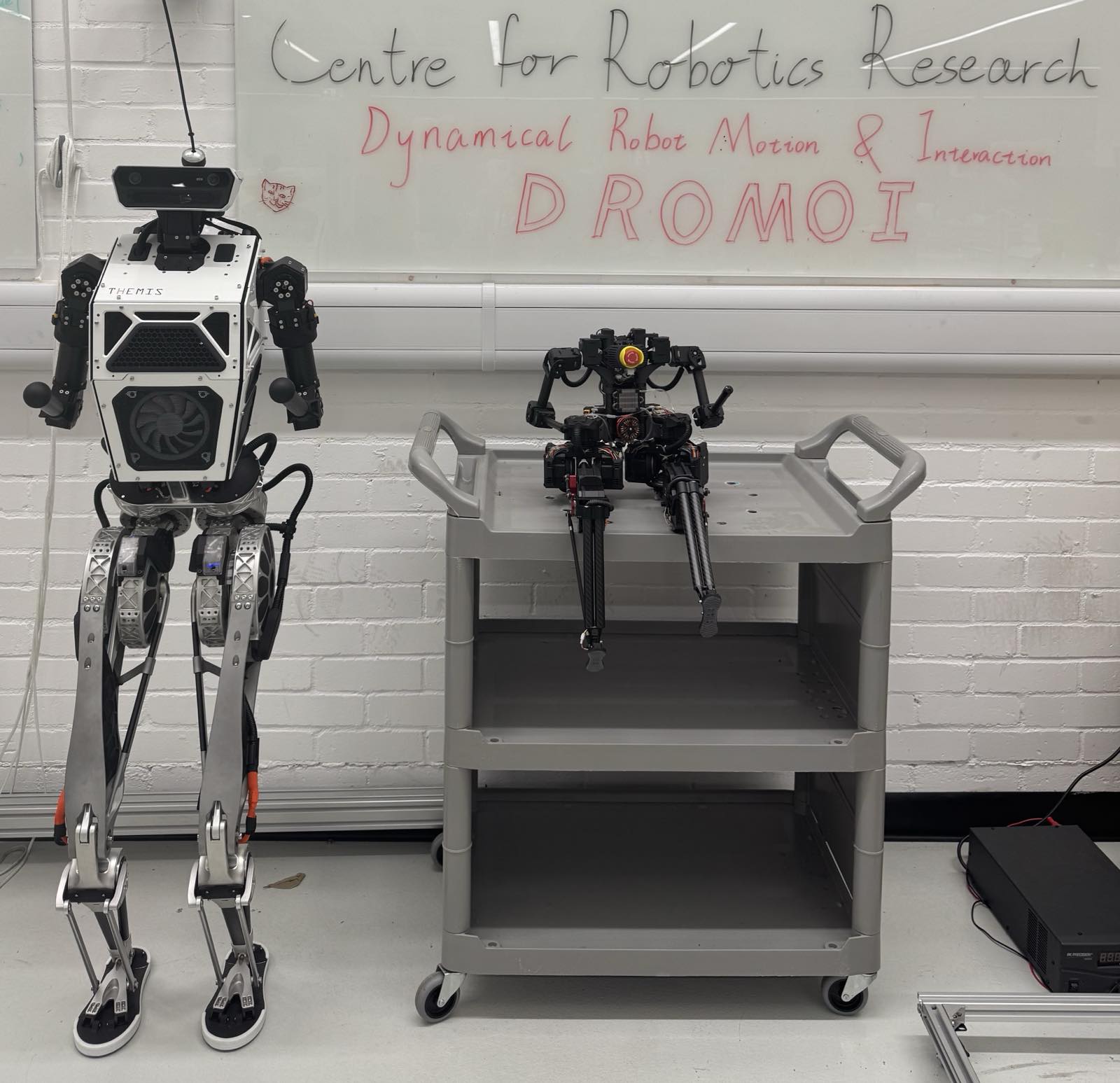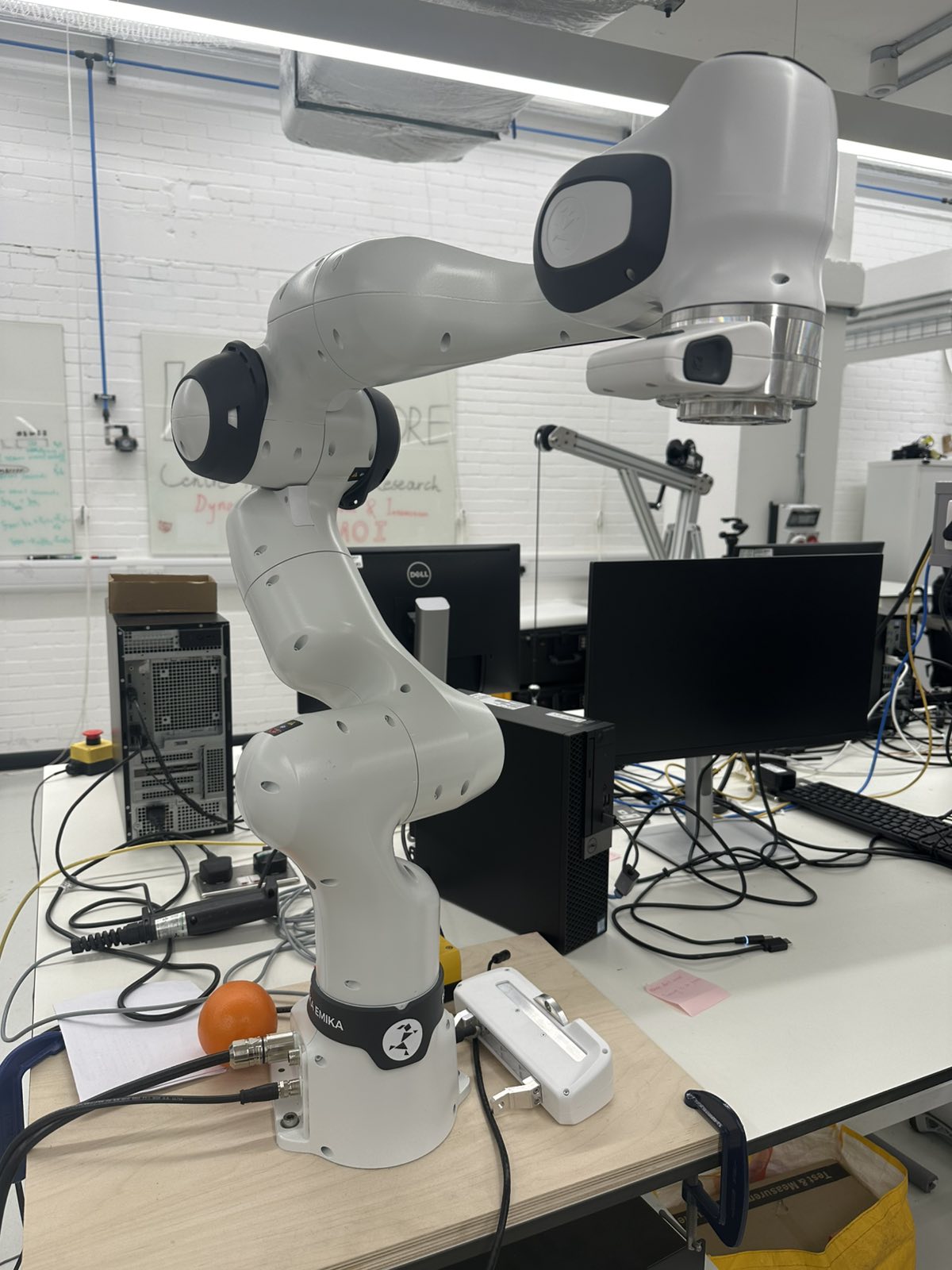DROMOI Lab Research
Our team predominantly focuses on five distinct, yet circumstantially overlapping, robotics research areas.
For more details relating to these research areas, please see below; for additional details about the DROMOI
Lab’s activities, click here.

Humanoid Robots
In virtue of possessing anthropomorphic mechanical structures, (bipedal) humanoid robots are ideally suited to operation in human-inhabited environments, thereby obviating the significant costs incurred by the restructuring that is often necessary to render workplaces/ factory floors/ buildings navigable by (non- anthropomorphic) robotic devices. However, bipedal robots are complex machines that comprise numerous degrees-of-freedom (DoFs) and diminutive support polygons, and, as a result, humanoid robotics constitutes one of the most challenging areas of robotics research.

Metamorphic Robots
Existing robot designs tend to follow the paradigm of their biological counterparts: one specific mechanical structure capable of adapting to one specific environment. Lacking the ability to transform precludes task versatility, environmental adaptability, and overall autonomy. To this end, robots can be endowed with varying degrees of reconfigurability to enable their kinematic structures to undergo dramatic changes. Self-reconfigurability endows a robot of a particular mechanical constitution – initially capable of only performing one set of tasks – with the ability to reconfigure itself. This enables it to alter its kinetic chain, (de-)activate degrees of freedom (DoFs), and switch between different types of actuators/sensors, thus engendering a new realm of applications, i.e. task versatility. Genuine autonomy, task versatility, and real-time responsiveness to dynamic environments by transitioning between distinct gaits/modes/media can be achieved via the realisation of real-time metamorphosing robots.

Lower-Limb Rehabilitation Exoskeletons
Stroke, as the second leading cause of death and third leading cause of death and disability globally, has become a major healthcare challenge. In the UK alone, there are 100,000 new stroke casualties every year and 1.3 million stroke survivors – their treatment incurs around 1.6 billion pounds’ worth of NHS spending, and an aggregate cost of £25.6 Bn, per annum; even more strikingly, the estimated global cost exceeds £566 billion. Despite the existence of manifold rehabilitation devices, the problem of domestic, lower-limb rehabilitation remains unresolved. Most existing lower-limb exoskeleton are hampered by their reliance on pre-configured, inadaptable hardware and software, which renders them unsuitable for stroke rehabilitation in residential settings, as per the WHO’s requirements. Moreover, these devices’ inability to offer both static and dynamic rehabilitation, through a single mechanical design, further compounds their applicability to residential settings. Our aim is to bring robotic rehabilitation to stroke survivors’ homes at a fraction of the cost, via the development of reusable, anatomically adjustable, reconfigurable lower-limb exoskeletons (visit our EPSRC REST section for more details).

Articulated-Soft Robots (ASRs)
Traditionally, robotic devices have constituted rigid-joint machines capable of executing predefined tasks with high accuracy and repeatability. Consequently, such robotic systems have been capable of executing only a limited range of tasks, and their possession of “rigid joints” has been detrimental to interactional safety. Hence, one of the aims of robotic hardware design research is to endow artificial machines with varying degrees of passive, mechanical compliance, which could in turn lead to the realisation of interactional performance enhancement and hardware robustness/permanence. Inherently compliant robots can be loosely subdivided into two categories: flexible-joint and flexible-link robots. In more recent works, one may also encounter the term “articulated-soft robots” (ASRs), as a means of referring to the former category. ASRs have the potential to offer both positioning accuracy and interactional safety, and there is thus an emergent requirement for more efficacious/ adaptable control schemes that will pave the way for their widespread adoption in practical settings. Although ASRs are naturally backdrivable, most existing algorithms do not fully exploit their immanent compliance to achieve improved interactional performance. To this end, our work focuses on the development of novel interaction control techniques, based on models of ASRs’ full underactuated dynamics, to render them capable of combining accurate position control with interactional safety.

Physical Human-Robot Interaction (pHRI)
Due to the ever-increasing demand for safe symbiosis of humans and robots, within human-inhabited environments, the topic of physical human–robot interaction (pHRI) has gained considerable popularity in recent years. pHRI methodologies are typically divided into two main categories, namely those that pertain to hardware design, and those relating to software development. In terms of the latter category, indirect force control techniques seem to prevail among roboticists, as compared to direct force controllers. This may in part be attributed to the implementational complexity of direct force controllers, which typically rely on environmental modelling, and/or direct usage of force feedback. Contrariwise, impedance control, qua indirect force control, relies on a contact-model-free approach, which, however, also offers the user a degree of tractability over the dynamical interactions between the robot and its environment. It is posited that interactional performance can be further improved through online modulation of a robot’s active impedance gains—a methodology that is typically referred to as variable impedance control (VIC). As a matter of fact, some works even postulate that the superior interactional, and locomotion, performance exhibited by biological machines is a direct result of the level of sophistication of their immanent “VIC mechanisms” (i.e., muscular activity). Despite VIC’s ability to yield improved tracking and interactional performance, active stiffness gain increases can be detrimental to closed-loop stability/passivity. To this end, our group has developed methodologies capable of provably preserving closed-loop stability – regardless of the impedance profile to be followed – even when applying these VIC schemes to underactuated systems, such as bipedal and/or articulated-soft robots.
